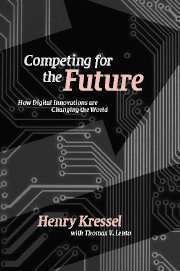Book contents
- Frontmatter
- Contents
- List of figures
- List of tables
- Acknowledgements
- Introduction
- Part I The technology – how electronic devices work – digital systems and software
- Part II Innovators, entrepreneurs, and venture capitalists
- Part III Global reach, global repercussions
- Appendix 1.1 Smaller, faster, more efficient MOSFETs
- Appendix 1.2 Building multi-transistor logic gates
- Appendix 1.3 MOSFETs in memory devices
- Appendix 1.4 CMOS reduces logic gate power dissipation
- Appendix 1.5 Laser diode basics
- Appendix 1.6 Light-emitting diodes (LEDs)
- Appendix 1.7 Photodetectors
- Appendix 1.8 Making fiber optic cables
- Appendix 1.9 Principles of LCD displays
- Appendix 2.1 The demise of analog computers
- Appendix 2.2 IP, TCP, and the Internet
- Appendix 2.3 Building an object-oriented program
- Index
Appendix 1.9 - Principles of LCD displays
Published online by Cambridge University Press: 07 December 2009
- Frontmatter
- Contents
- List of figures
- List of tables
- Acknowledgements
- Introduction
- Part I The technology – how electronic devices work – digital systems and software
- Part II Innovators, entrepreneurs, and venture capitalists
- Part III Global reach, global repercussions
- Appendix 1.1 Smaller, faster, more efficient MOSFETs
- Appendix 1.2 Building multi-transistor logic gates
- Appendix 1.3 MOSFETs in memory devices
- Appendix 1.4 CMOS reduces logic gate power dissipation
- Appendix 1.5 Laser diode basics
- Appendix 1.6 Light-emitting diodes (LEDs)
- Appendix 1.7 Photodetectors
- Appendix 1.8 Making fiber optic cables
- Appendix 1.9 Principles of LCD displays
- Appendix 2.1 The demise of analog computers
- Appendix 2.2 IP, TCP, and the Internet
- Appendix 2.3 Building an object-oriented program
- Index
Summary
Flat-screen displays based on organic materials dominate the display device field. Chief among them for its commercial importance is the liquid crystal display, or LCD.
Liquid crystals are a class of organic materials with very interesting properties. Their molecular alignment (and hence their optical properties) change reversibly with temperature, as well as under the effect of moderate electric or magnetic fields.
At high temperatures these materials exhibit the properties of liquids, while below a critical temperature they assume more of the properties of solids. For example, as a result of this transformation, a liquid crystal film can change reversibly from a milky fluid, opaque to light, to one which is transparent to visible light.
The discovery of liquid crystals dates to the nineteenth century. However, the materials languished without serious applications until the late 1960s, when research at RCA Laboratories found an application for them in flat-screen displays. The researchers achieved this by applying electric fields to thin liquid crystal films to change the optical properties of the materials.
This discovery made two types of display applications possible as materials were developed. First, applying an electrical field to certain classes of liquid crystals changes them from light absorbers to good reflectors. Second, in other materials, the applied field can make the film either opaque or transparent to visible light; hence the film can become a “light valve.”
Flat-screen display technology has proven to be crucial to the mass acceptance of sophisticated electronic systems.
- Type
- Chapter
- Information
- Competing for the FutureHow Digital Innovations are Changing the World, pp. 374 - 376Publisher: Cambridge University PressPrint publication year: 2007



